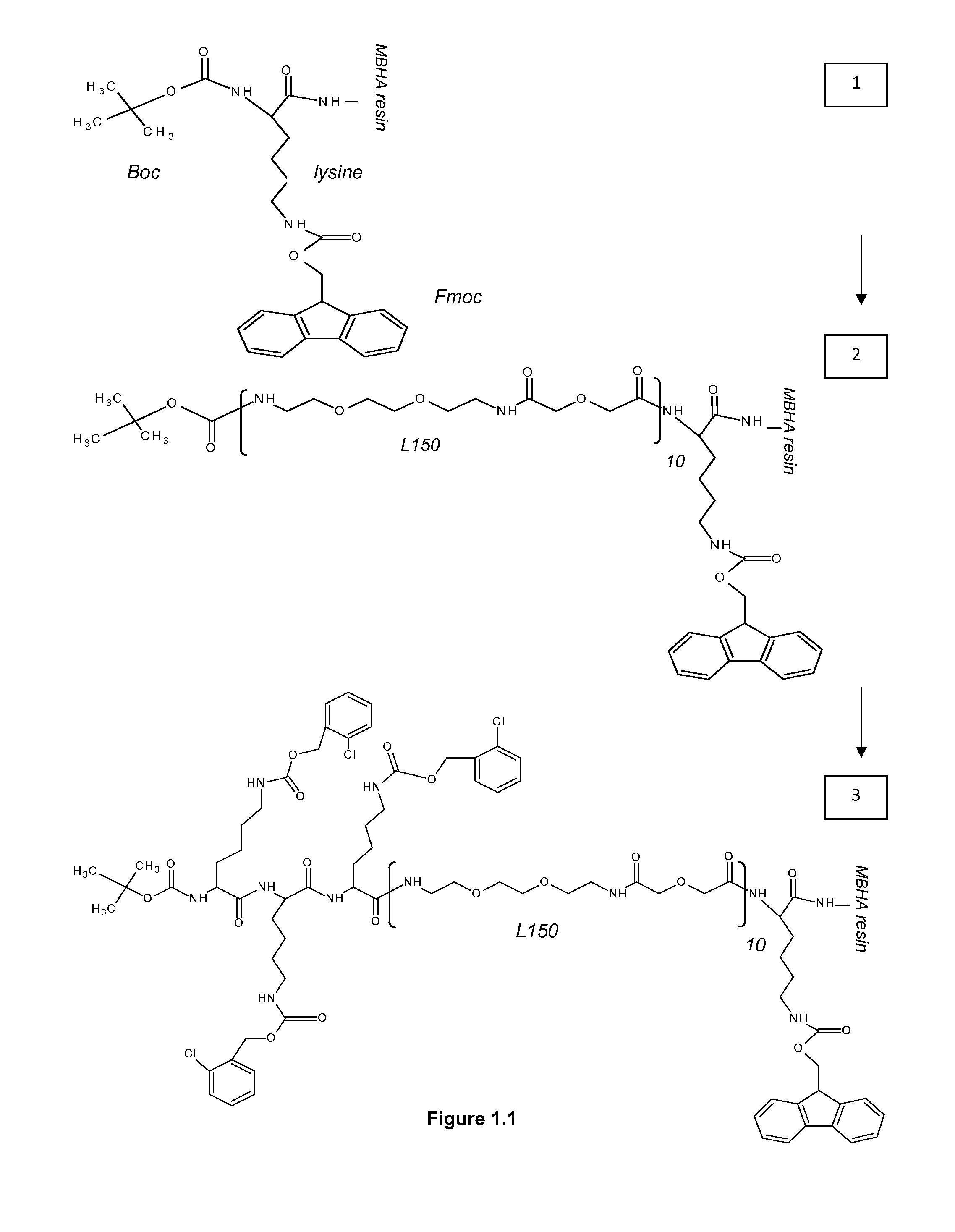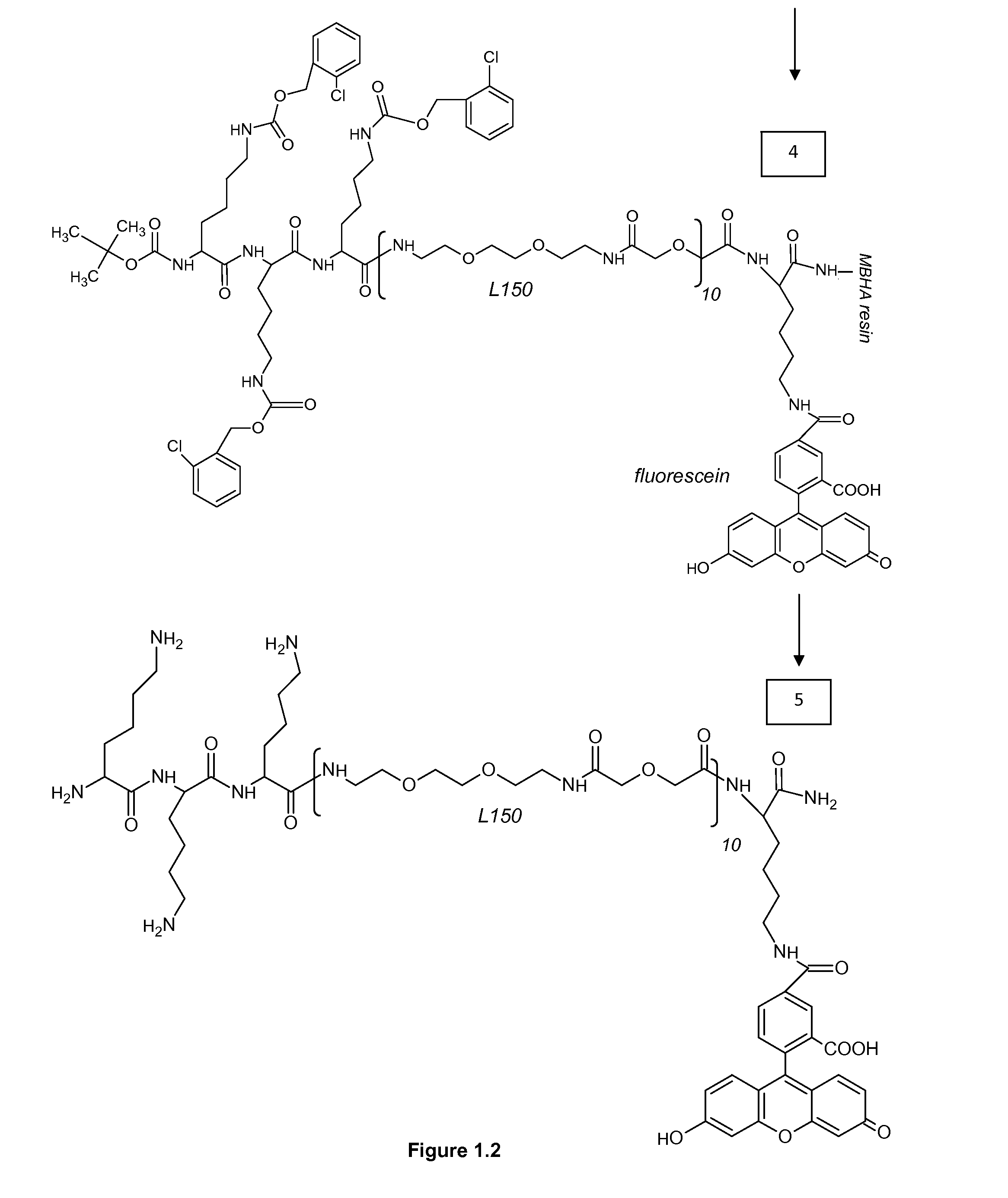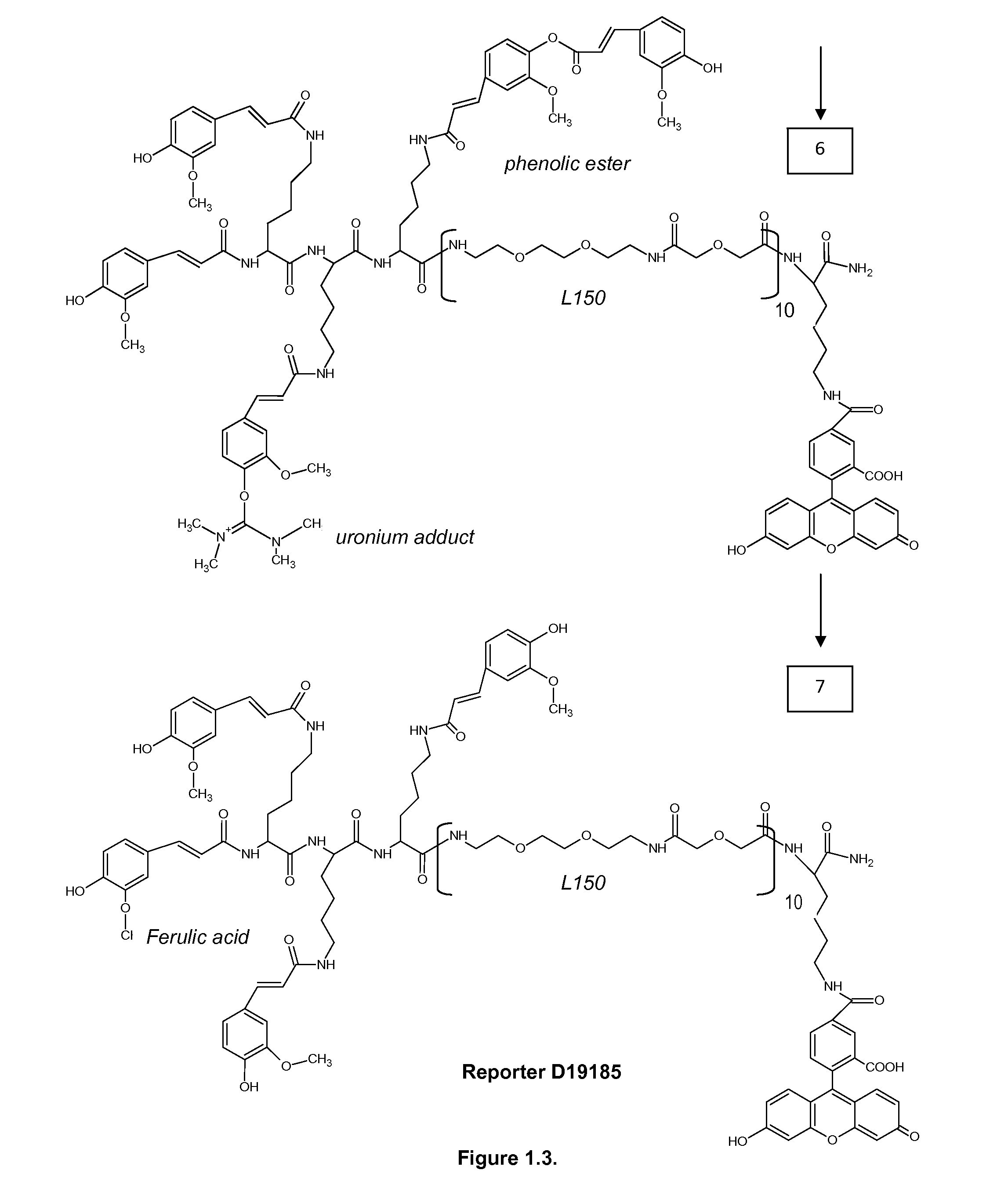Methods and compounds for detection of molecular targets
a molecular target and molecular target technology, applied in the field of methods and compounds for can solve the problems of diffuse signals, various components dissociation, and the tendency of detection experiments to produce relatively diffuse signals, so as to improve the detection of molecular targets, the detection speed is faster, and the detection accuracy is improved.
- Summary
- Abstract
- Description
- Claims
- Application Information
AI Technical Summary
Benefits of technology
Problems solved by technology
Method used
Image
Examples
examples
1. Reporters
ABBREVIATIONS
[0321]MBHA 4-Methylbenzhydrylamine[0322]NMP N-Methyl Pyrolidon[0323]HATU 2-(1h-7-azabenzotriazole-1-yl)-1,1,3,3 tetramethyl uronium hexafluorophosphate; methenamminium[0324]DIPEA Di / isopropyl EthylAmine[0325]DCM Dichloro Methane[0326]TFA TriFluoroacetic Acid[0327]TFMSA TriFluor Methyl Sulphonic Acid[0328]Fer Ferulic acid[0329]Flu Fluorescein[0330]Tyr Tyrosine[0331]Lys Lysine[0332]Dex Dextran[0333]HPLC High Performance Liquid Chromatography[0334]equi. Equivalent[0335]L30 1,10,16,25-tetraaza-4,7,13,19,22,28-hexaoxa-11,15,26,30-tetraoxo-triacontane[0336]L60, L90, L120, L150—polymers of the formula (L30)q, wherein q is 2, 3, 4 or 5[0337]CIZ 2-chloroZ=2-chloro Benzyloxycarbonyl[0338]FITC FlouresceinlsoThioCyanate[0339]HRP Horse Radish Peroxidase[0340]PNA-X PNA backbone (N-(2-aminoethyl)-glycine) with different substituents coupled to the central nitrogen[0341]A adenine-9-acetic acid,[0342]C cytosine-1-acetic acid,[0343]D 2,6-diaminopurine-9-acetic acid,[0344]G gu...
experiment 1
Slides were Sequentially Incubated:
[0430]1. Primary antibody 80 seconds. (300 seconds for “Link”antibodies)[0431]2. Goat-anti-Mouse F(ab′)-HRP, 20 nM, 80 seconds[0432]3. Reporter D19185 1200 nM+5.6 mM DAB 200 seconds[0433]4. Anti-FITC F(ab′)-HRP, 100 nM, 140 seconds[0434]5. 5.6 mM DAB 200 seconds.
[0435]Primary antibodies were diluted in antibody diluent S0809 (DAKO) as indicated in the Antibody Table (above).
[0436]Goat-anti-Mouse-HRP and anti-FITC-HRP were diluted in buffer with 0.4% casein, 2% BSA, 2% PEG 3000, 0.1% procline, 0.05% 4-aminoantipyrine, 0.1% Tween-20, 100 mM NaCl, 10 mM Tris pH 8.0 (ABCPT buffer).
[0437]Reporter D19185 (Fer4-L305-Flu1) and DAB of step 3, and DAB of step 5 were diluted in water solution of 50 mM imidazol-HCl pH 7.4, 5.6 mM hydrogen peroxide, 0.1% Tween-20
[0438]Washings between the steps were performed in S0809 (in S0809 or 10 mM CHES pH 9, 0.1% Tween-20 after step 3), each 2 min at room temperature.
[0439]The procedure was tested using 15 different antib...
experiment 2
[0441]Slides were Sequentially Incubated:[0442]1. Primary antibody, 140 seconds. (300 seconds for “Link”antibodies”)[0443]2. Goat-anti-Mouse F(ab′)-HRP (D19150), 30 nM, 200 seconds[0444]3. Reporter D19059 1200 nM+2.8 mM DAB 200 seconds[0445]4. Anti-FITC F(ab′)-HRP (D19142), 150 nM, 140 seconds[0446]5. 2.8 mM DAB 200 seconds.
[0447]Primary antibodies were diluted in antibody diluent, S0809 (DAKO) 10 times more (5 times more for “Link” antibodies) than indicated in the Antibody Table above.
[0448]Solvents for secondary antibody, reporter and DAB, and washing buffer were as in experiment 1.
[0449]The procedure was tested with the same 15 different antibodies on same 12 different human tissues (above) using incubation time that is about 9 times shorter than incubation time of the Envision Flex. Both staining pattern and quality were essentially identical to the staining of experiment 1. There was no background on control slides treated with antibody diluent alone in step 1.
[0450]The experi...
PUM
 Login to View More
Login to View More Abstract
Description
Claims
Application Information
 Login to View More
Login to View More - R&D
- Intellectual Property
- Life Sciences
- Materials
- Tech Scout
- Unparalleled Data Quality
- Higher Quality Content
- 60% Fewer Hallucinations
Browse by: Latest US Patents, China's latest patents, Technical Efficacy Thesaurus, Application Domain, Technology Topic, Popular Technical Reports.
© 2025 PatSnap. All rights reserved.Legal|Privacy policy|Modern Slavery Act Transparency Statement|Sitemap|About US| Contact US: help@patsnap.com



